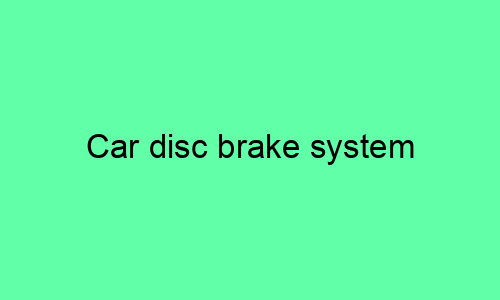Car Disc Brake System
Disc brakes are a type of brake used on cars and other vehicles. They consist of a flat, circular disc that is attached to the wheel, and a caliper that is mounted on the suspension. The caliper contains two or more brake pads that press against the disc to slow or stop the wheel.
Advantages of disc brakes
Disc brakes have a number of advantages over drum brakes, including:
- Improved stopping power: Disc brakes provide more stopping power than drum brakes, especially in wet or icy conditions.
- Reduced fade: Disc brakes are less likely to fade than drum brakes, even after repeated hard stops.
- Better heat dissipation: Disc brakes dissipate heat more effectively than drum brakes, which helps to prevent brake fade and improve braking performance.
- Compact design: Disc brakes are more compact than drum brakes, which allows for more space in the wheel well.
Disadvantages of disc brakes
Disc brakes also have some disadvantages, including:
- Increased cost: Disc brakes are more expensive than drum brakes.
- Increased weight: Disc brakes are heavier than drum brakes.
- Increased noise: Disc brakes can be noisier than drum brakes, especially at low speeds.
How disc brakes work
Disc brakes work by converting kinetic energy (the energy of motion) into heat. When the brake pedal is applied, the caliper moves the brake pads against the disc. The friction between the pads and the disc creates heat, which causes the disc to slow down. The wheel, which is attached to the disc, also slows down.
The amount of braking force is determined by the amount of pressure applied to the brake pedal. The harder the pedal is pressed, the more pressure is applied to the pads and the greater the braking force.
Disc brake components
The main components of a disc brake system include:
- Brake disc: The brake disc is a flat, circular disc that is attached to the wheel.
- Caliper: The caliper is a housing that contains the brake pads.
- Brake pads: The brake pads are made of a friction material that presses against the disc to slow or stop the wheel.
- Brake lines: The brake lines carry brake fluid from the master cylinder to the calipers.
- Master cylinder: The master cylinder is a reservoir that stores brake fluid and pressurizes it when the brake pedal is applied.
Disc brake maintenance
Disc brakes require regular maintenance to ensure that they are working properly. This maintenance includes:
- Checking the brake pads: The brake pads should be checked regularly for wear. If the pads are worn down to less than 1/4 inch, they should be replaced.
- Checking the brake fluid: The brake fluid should be checked regularly for leaks and contamination. If the brake fluid is low or contaminated, it should be flushed and replaced.
- Inspecting the brake lines: The brake lines should be inspected regularly for leaks and damage. If the brake lines are damaged, they should be replaced.
Conclusion
Disc brakes are a safe and effective way to stop a car. They provide more stopping power than drum brakes, and they are less likely to fade after repeated hard stops. Disc brakes are also more compact and efficient than drum brakes.
However, disc brakes are also more expensive and heavier than drum brakes. They can also be noisier than drum brakes, especially at low speeds.
Overall, disc brakes are a good choice for cars that need good braking performance. They are more expensive than drum brakes, but they offer a number of advantages, including improved stopping power and reduced fade.






